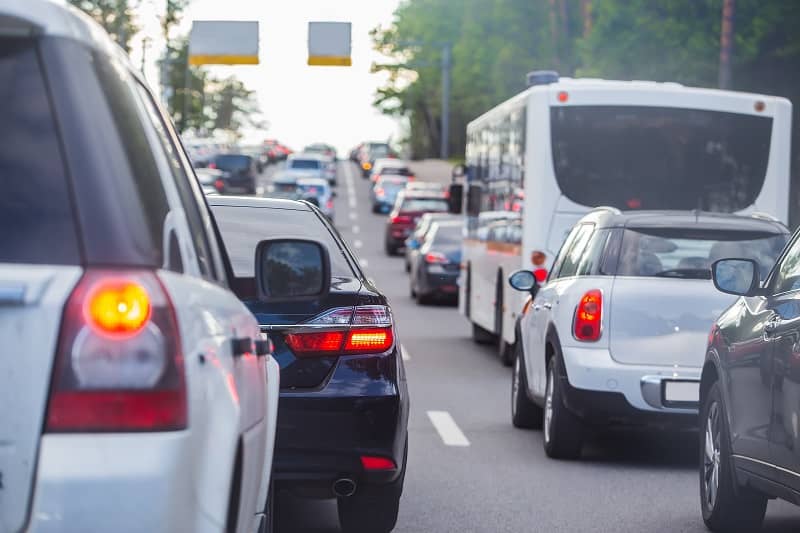The Portland metro region tried everything to reduce automobile reliance. It’s time to acknowledge the resulting congestion.
By Vlad Yurlov
Oregon’s transportation policy is in an alternate reality, the “no build” alternative, to be exact. It’s been more than 30 years since Oregon built a new highway, and its metropolitan areas are pressured to say “no” to parking lots and any new automobile capacity. So it’s no wonder that the Oregon Department of Transportation reports “congestion is expected to become more severe and spread beyond typical peak periods in many areas of the state.”
We got here by way of a comprehensive law with a boring title. In 1991, Oregon adopted the Transportation Planning Rule (TPR), which requires most metropolitan areas to “reduce reliance on the automobile” by decreasing vehicle miles of travel (VMT) and parking spaces per capita. The TPR was born out of the death of a highway and grew to a sprawling behemoth that pressures local governments to disinvest from the automobile infrastructure that enabled the state’s growth throughout the early 20th Century.
In the late 1980s, state and local governments thought a Western Bypass could help commuters avoid Portland’s congested downtown streets. But environmentalists and others pointed to computer models to claim “transportation demand management (TDM) could reduce congestion without expanding roadway capacity. TDM strategies focus on increasing alternative transportation access by doing things like adding sidewalks and cycling lanes and then paying employees to use them. The computer models assumed local governments could increase livability by subsidizing high-density multimodal centers instead of additional road capacity. The decision to scrap the Western Bypass and follow the activists’ approach bled into the TPR. Instead of building bridges and highways, the Portland metro region tried its hand at “managing demand.”
The rebuilt Sellwood Bridge is an example of this approach backfiring. By 2004, the Sellwood Bridge was unable to keep up with traffic demands. Despite the fact that a two-lane bridge was projected to produce “grossly unacceptable” traffic congestion by 2015, Metro recommended no new crossings be constructed across the Willamette River. Instead, local governments focused on transportation demand management to address rising congestion on surrounding streets. Tacoma Street in Sellwood served four lanes of traffic into the east side of the bridge. But the City of Portland “managed demand” by cutting two lanes and calling it a Main Street instead of a vital arterial. The lost roadway and parking spaces became sidewalks and bike lanes. The speed limit was cut from 35 miles per hour to 25 miles per hour. This strategy scored points under the TPR, but congestion only got worse.
Cars piled up on Tacoma’s two-lane bottleneck and spilled out into the neighborhood. Public officials refused to acknowledge what the environmental impact statement for the Sellwood Bridge clearly found: walking and cycling facilities are “an addition to automobile traffic, not a substitute for it.” But Portland planners insisted that Tacoma Street didn’t have the responsibility of serving regional transportation needs, so two lanes were enough. In the end, limiting Tacoma Street to two auto lanes made it much easier for planners to stop a wider Sellwood Bridge replacement. After all, the Tacoma Street “road diet” was in both Metro’s and Portland’s plans to comply with the Transportation Planning Rule.
Proponents of the Transportation Planning Rule claim reducing vehicle miles of travel per capita is necessary to reduce pollution. But before the rule was adopted, Oregon’s air quality was already improving. And air quality continues to improve, because automobile fuel efficiency keeps increasing. Yet environmentalists demanded the TPR include VMT reduction targets to make sure local governments elsewhere in the state acted with as much zeal as the Portland metro region.
Despite the region’s effort at “demand management,” traffic congestion increased under TDM policies. As the population increased without adequate expansion of roadway capacity, the cost of using a car increased. And while some drivers may have switched to alternative transportation modes, the overall mode share hasn’t significantly shifted since 1990. Despite the Transportation Planning Rule’s promises of increased livability, the regions that implemented the rule most aggressively face some of the worst congestion. After three decades of misplaced priorities, it’s time to declare the Transportation Planning Rule a failure and repeal it.
Vlad Yurlov is a policy analyst at Cascade Policy Institute, Oregon’s free market public policy research organization.












